Photo


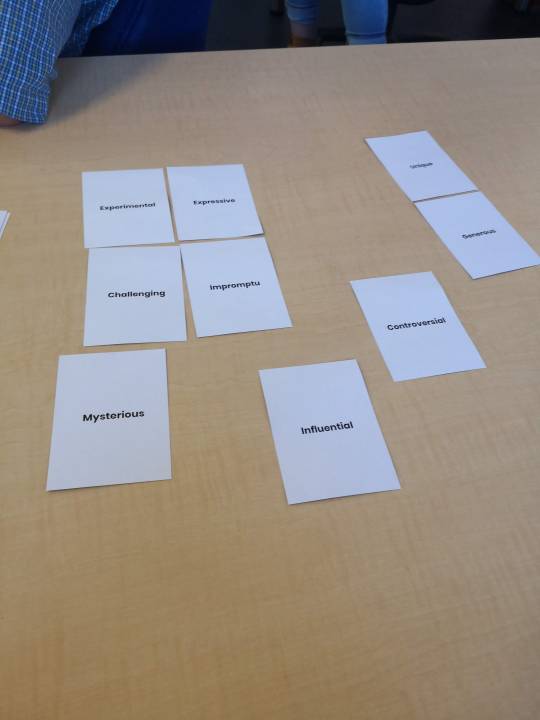
Design for Health and Well being - Week 1
It was really difficult for me to choose an image that represents health and well being to me. The way I represent it is a bit more abstract, I picked a colour. I chose the Pantone 2017 Colour of the Year - “Greenery”. To me this colour represents the idealistic epitome of being healthy and having a good spiritual mind. It represents thriving in your life.
“Greenery is a fresh and zesty yellow-green shade that evokes the first days of spring when nature’s greens revive, restore and renew. Illustrative of flourishing foliage and the lushness of the great outdoors, the fortifying attributes of Greenery signals consumers to take a deep breath, oxygenate and reinvigorate. “
What does health and well being mean to me?
This is a really difficult question for me as it is something that I had never put thought into. To have a livelihood and motivation in life, you would need to be healthy and content spiritually and mentally. The definition and perspective of health and being healthy is different to everyone.
“How did health move from a state of being to a commodity?”. I guess this could mean that marketing. The way I interpret this is that an ideal state of health is being marketed towards everyone. Some examples of this trend are protein and skincare supplements, detox cleanses, vegan or gluten free diets and much more. These are a commodity as they seem to be unnecessary or have very minor contributions to your overall health.
Health - Individual physical requirements. Biological.
Well being - More spiritual and mental well being. Influenced by relationships and environment.
Impairment - It may be an invisible or partial disability. You just have difficulty doing daily tasks.
Disability - It is more physical. You cannot do daily tasks alone.
Activities
This was an exercise we did in class. We picked up an item that was a blunt metal pencil. We were tasked with creating a metaphor based on one of the 4 words. It was abstract and absurd at first but it was really good to exercise and expand on thoughts. This was a very interesting way of thinking.
We also played another game, there was an activity where we had to separate different words into two categories - Design and Health. Most word associations were easy to put under a category. We were reminded that we all had the mindset of designers. If medical students were to do this activity their word associations would be very different.
This activity showed me that it is important to consider things in a different perspective. Not only your perspective, but the perspective of others. Everyone may interpret things in a different way, so you should not make assumptions that everyone will view it the same as you do.
References
PANTONE. (2017). COLOR OF THE YEAR 2017 - Pantone Color of the Year 2017 | Greenery | Nature's Neutral. Pantone - Pantone Color, Chips & Color Guides | Color Inspiration. https://www.pantone.com/color-intelligence/color-of-the-year/color-of-the-year-2017
Exhibition In-a-box. (2020, February 29). Good Health Design – Home. https://www.goodhealthdesign.com/projects/exhibition-in-a-box
2 notes
·
View notes
Text
Hello I’m Back
I think I will be using this Tumblr again for some papers this year.
2 notes
·
View notes
Text
Process Journey Blog Post.
Here is a summary of my process journey. There are also some other blog posts which are more relevant to the inspiration and ideas behind it.
All of the blog posts can be found here.
Concepts:
Wearables
Concept Update
Final Concept
Choosing Wool
Contexts and Research:
Fast Fashion in New Zealand
Reduce, Reusing, Recycling Clothing.Reducing
The Upcycle
Existing Materials
Sustainable Brands
Adaptive Clothing
Knit Your Dog
Stitch, Fibre, Metal and Mixed Media
Recycled Textiles
Better Cotton Initiative
Wool
Nostalgia
Testing and Process:
Survey
Concept One
Turning Textiles into Fibres
Turning Textiles inro Fibres II
Felting Intro
Felting Part I
Felting Part II
Carding
Making Rovings
Final Process:
Felting Final Textile
Final Textile
Project Legacy
Final Installation
Final Reflection
0 notes
Text
Project Reflection
Making a textile was something that I had been wanting to do for a while. Incorporating aspects of nostalgia from my previous project brief, I have successfully fulfilled the required properties for this project.
This project was also one that I had worked alone on. I was able to decide the processes and the final outcome. However, something I could have improved was the user testing. Since I was working alone, I used my own judgement to decide which felted materials worked and which ones were not as aesthetically pleasing or not as suitable as a textile. If I were to continue or repeat this, I would acquire more feedback from people. It could be anyone as everyone is a potential user, from BCT students to industry partners. This would improve my judgement of the experimental materials.
I also would have liked to explore more areas in which fibres can be joined to make a textile. I only really tried felting in different ways, I could have looked into stitching and other things.
0 notes
Photo


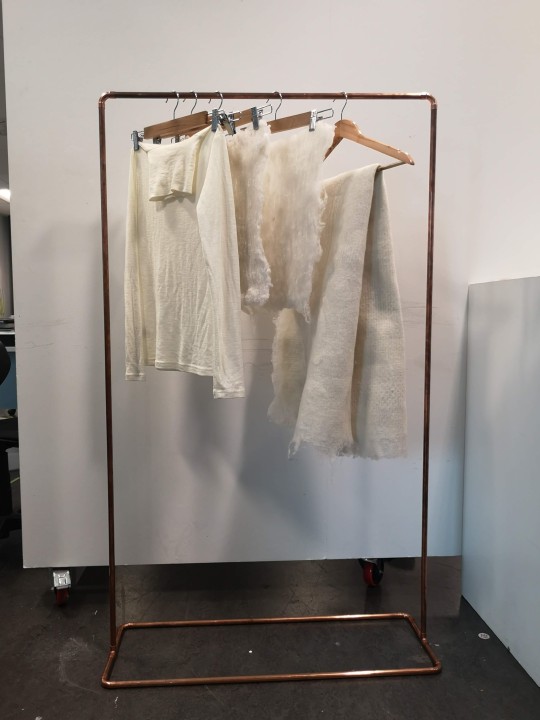
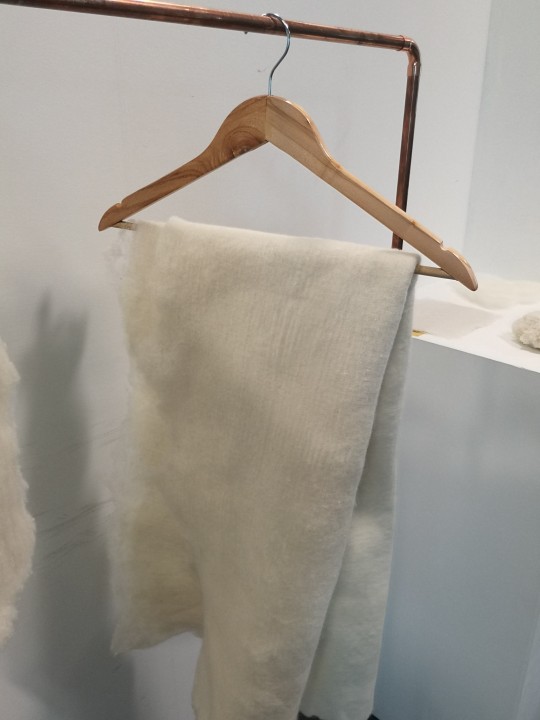
Final Installation
Setup
For my final setup, I’ve put large sample pieces of the materials I used in order of my actual process. This includes
A merino wool shirt - What I began with
Carded batt - Carded chunky thread and fibres that form a wool batt
Blended batt - Refined recycled fibres blended with new wool
Felted textile - A felted textile made from blended new and recycled merino wool
There are also a few samples of some original test swatches of other materials. This includes recycled wool and polyester blends. I also have some recycled fibres to show the audience.
I re-purposed the frame from my old project to use for this one. I shortened it lengthwise. I also used some wood and metal hangers to hang up the textiles.
Slides
For my final presentation, I decided to use my laptop to put up slides. These will be based on the crit slides. It would be adjusted to be based more on my process of creating my final textile.
Open Studio
Although I had planned to add posters explaining the process onto the actual rack for the presentation, I have them on the slides already. So I am unsure if it will be necessary. I do plan to print out posters so that the general public will have a better understanding of my project.
0 notes
Text
Revisiting Nostalgia
This is a blog post that I have forgotten to post from my drafts.
Now that I am able to link nostalgia into my project as well. I am able to emphasize the sentimentality of the final artifact that I was able to create from an old wool shirt.
I grew up wearing a lot of wool clothing. These items were then passed down to my siblings, and then mostly donated. I was able to find that old worn woolen shirt which was the same as what I used to wear. Using this to represent my past I was able to recreate it into something completely different that I could still use. To me, the sustainable recycling of the wool fibres are able to keep the past memories present. The final textile I have created is able to evoke nostalgia personally. If it was the recycling of another persons old textiles into something that they can use now, it would still have the same effect for them. The nostalgic feelings may not be universal but it is more personal.
Research : Nostalgia - The basics

Nostalgia was first documented as a disease. The term was created by a medical student as a word to describe the symptoms that Swiss mercenaries had when fighting away from home.
In modern times, nostalgia is a positive emotion, pleasant feeling of the longing and familiarity of the past. This feeling is usually triggered by many different senses such as sound, sight and smell. Common things that evoke feelings of nostalgia are music, colours and smells. When feelings of nostalgia are evoked it usually brings positive recollections of past events, people and places.
Nostalgic memories tend to be social in nature, such as a group of friends just sharing stories and past experiences. However, it is predominantly more self based but involve others in cherished life experiences and such as graduations, weddings, family vacations, holidays, religious rites of passage. When people feel nostalgic they are revisiting personally treasured and generally positive life experiences and recollections of childhood.
References Below
Keep reading
1 note
·
View note
Text
Project Legacy
Now that I have finished the final textile. I have experienced the full process of wool recycling on a small scale, I have also learnt a lot about the unique properties of wool fibres.
The textile that I made can be carded again to turn back into fibres if necessary.
Wool is a sustainable material. It has unique properties which make it universally useful for different textiles from garments to upholstery and carpets etc. Wool recycling could potentially bring awareness to fast fashion. The wool recycling process can help consumers make wiser decisions on what garments and textiles to buy. They can also help with emphasizing the sentimentality and appreciation for clothing. There is an opportunity for wool recycling and wool farming to improve as an industry nationally.
There is a lack of textile recycling incentives in New Zealand. Many people do not know that you are able to recycle textiles. This was what I had thought before completing this project. I thought that the clothes that you purchased were single use, and the only option is to donate it after use. This is where we could raise awareness and emphasize textile recycling and conscious consumerism.
0 notes
Text
Why did you choose wool?
Looking through my blogs, I have never really explained why I decided to focus on recycling wool as a material as compared to cotton.
The criteria for the material required it to be natural and potentially sustainable. Synthetic fibres can be recycled but they require commercial processes and chemical additives. This makes it very difficult for a small scale project.
One of the materials I looked into was cotton. Cotton is natural and made from plant fibres so it is still biodegradable after use. Cotton can be recycled. However the process of returning the textiles back into fibres uses various shredding machines. This will shorten the length of fibres which will be much more difficult to reuse. For example, Levi’s can only use up to 20% recycled materials to meet standard quality control. This may be because the shorter recycled fibres do not bond well together, there is not as much hold. This means that the overall textile would be weaker.
The cotton recycling process is also commercial so it would be difficult to replicate in small scale. The scrap cotton textiles that I had was also much more difficult to separate than the wool knits. The wool was very strong so it was easy to brush back into fibres.
References
Bain, M. (2015, August 26). Why cotton is so difficult to recycle'and how clothing retailers hope to change that. Retrieved from https://qz.com/487423/why-cotton-is-so-difficult-to-recycle-and-how-clothing-retailers-hope-to-change-that/
Bain, M. (2015, July 21). Levi's just made it incredibly simple for Americans to recycle their old clothes. Retrieved from https://qz.com/459815/levis-just-made-it-incredibly-simple-for-americans-to-recycle-their-old-clothes/
0 notes
Text
Wool Industry Research
youtube
As with my previous research into existing materials. This is the further research that I have done specifically on wool during the making process of my project.
Wool begins as fleece from a sheep. It is shaved off a sheep usually once a year in spring when their fleece is the optimum length as it will grow continuously. Shearing usually does not physically harm the sheep, there may be small cuts or nicks from the shaver. However, the entire process may still be stressful for the sheep. The wool from the sheep is then sorted and then washed. The wool is then carded into fibres. In commercial production, the entire process is mechanical and automated from carding to making rovings and spinning yarn.
Wool is has many different properties which make it universally beneficial. It is naturally breathable allowing it to absorb moisture and then move it to evaporate in the air and odour resistant. It is also wrinkle resistant, adapts to body heat, soft, fire and UV resistant. Wool is also 100% natural and is biodegradable.
Wool only has a 1.3% share in the international textile market. However, it makes up to 5% of recycled fibre textiles. Wool is a valuable material as it is very suitable for recycling. The recycled fibres stay strong and can be converted to long lasting products such as garments, mattresses and upholstery.
The wool industry in New Zealand is declining. Even though there are still approximately 27 million sheep. Many of these sheep only produce coarse wool which is stronger and cheaper but is generally used for carpets and upholstery. Merino wool is preferred for garments. However, these sheep do not thrive in New Zealand farms. They are adapted to drier high country areas like Otago.
The consumers have forgotten the unique benefits and properties of wool in comparison to synthetic materials.
References
How it's Made. (2015, May 23). How It's Made Wool [Video file]. Retrieved from https://www.youtube.com/watch?v=FsRxMsBGuFs
RSPCA. (2019, May 1). What are the animal welfare issues with shearing of sheep?. Retrieved from https://kb.rspca.org.au/knowledge-base/what-are-the-animal-welfare-issues-with-shearing-of-sheep/
Li, R. (2019, August 31). Research - Existing Materials [Web log post]. Retrieved from https://rachael-li-bct.tumblr.com/post/187386576854/research-existing-materials
Noted, & Ralston, B. (2019, May 18). NZ innovators are leading a wool revolution ? is it time to get behind them?. Retrieved from https://www.noted.co.nz/money/money-business/wool-revolution-nz-innovators-is-it-time-to-get-behind-them
Woolmark. (n.d.). Properties of the wool fibre. Retrieved from https://www.woolmark.com/about-wool/wool-fibre/?enforce=true
Chalmers, H. (2018, November 26). Genetic changes will allow merino sheep come down from the mountains. Retrieved from https://www.stuff.co.nz/business/farming/108707489/genetic-changes-will-allow-merino-sheep-come-down-from-the-mountains
0 notes
Text
Final Textile
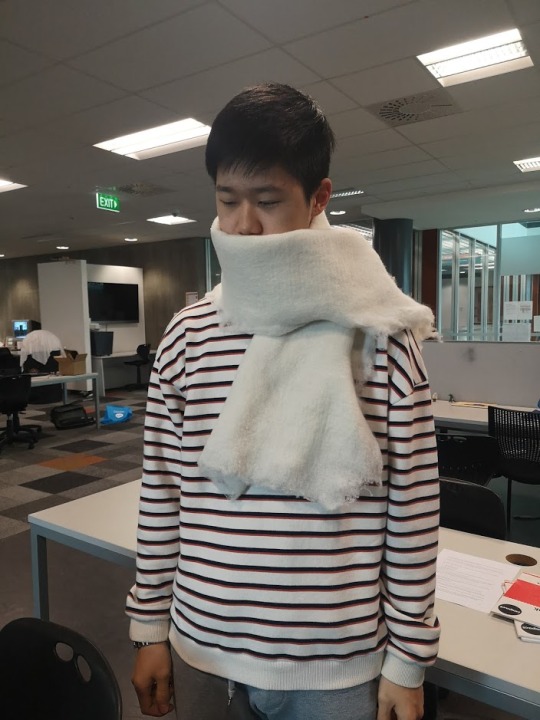
The final textile consisted of approximately 25% recycled wool and 75% new wool. Ideally it would be 50/50 of each but I had run out or recycled wool. The texture of the textile is still very soft, there are no chunky bits or lumps. There are still some patchy areas where there is less fabric but it is barely noticeable. I had also noticed that the textile becomes less stiff with wear which is a good property for certain potential uses.
The feedback that I received from other students were that it was very soft. It had really good insulating properties since it is 100% merino wool, which made it very warm to wear. It was used as a scarf as shown in the picture above with @dinomightofficial. This could be a potential use for the future of this textile.
I was also trying to decide if I should trim the sides off of the textile to make it more neat and “wearable” However leaving it as shows the process behind it as well. You are able to see some of the recycled fibres as well as the new fibres.
0 notes
Text
Felting for my Final Artifact
After all the tests that I have done with roving, I decided to choose to use felting to make my final artifact. I have been avoiding this method as I was worried that it would be too difficult to turn back into fibres. With rovings, the process could be repeated easier as it is only lightly felted, the fibres are not as tightly tangled together as felting. Before I actually felted my final, I tested brushing out a small sample of felted new and recycled wool using a carding board and brush. It separated very well. I then reused this sample to add into my final textile.
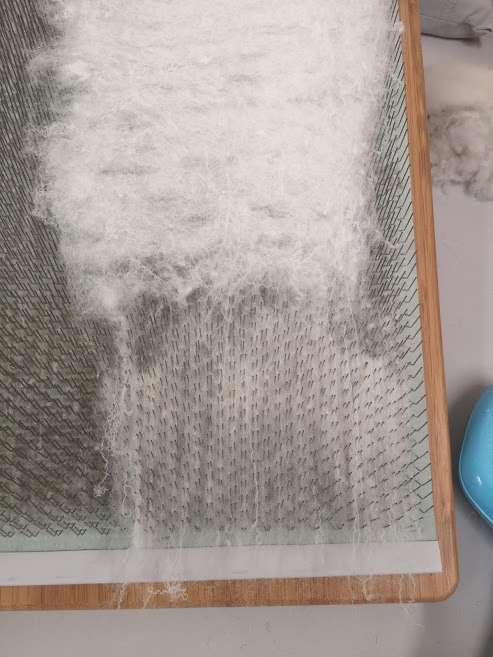

The process of making the final textile was relatively simple. I used the drum carder to mix my last bag of recycled wool with new wool. It was approximately 25% recycled wool and 75% new wool. Ideally it would have a bit more of the recycled wool , 50/50 but I ran out. The final textile would still turn out very similar if it was half and half. Using the batts from the drum carder, I felted the base together using a large piece of fabric. I then peeled off the thin sheet of my textile and felted another layer of batts onto it. This made it much more thicker and stronger. There was some patchiness where there was less material that I was able to fix by adding bits of wool and then felting over.
0 notes
Photo
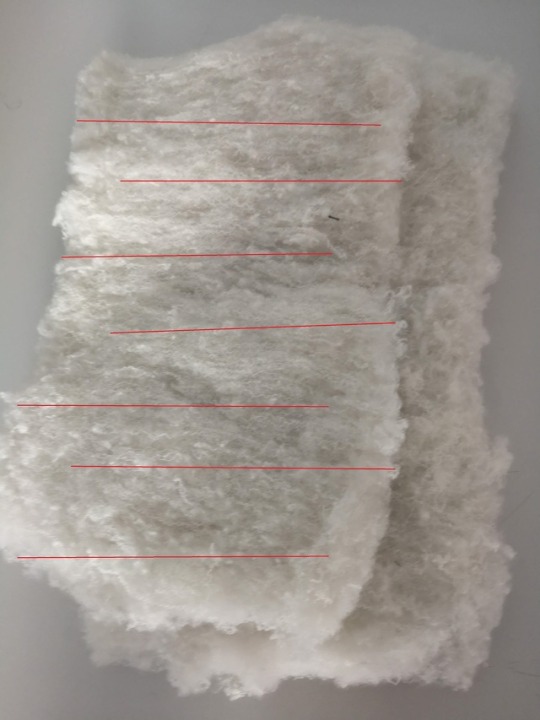
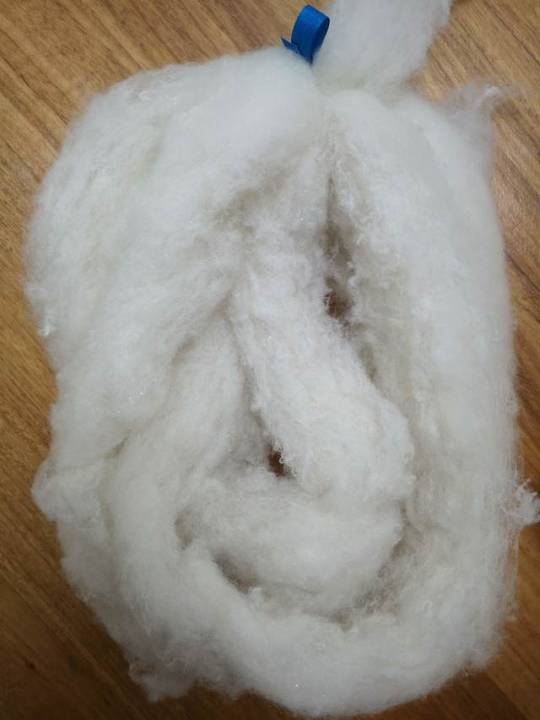

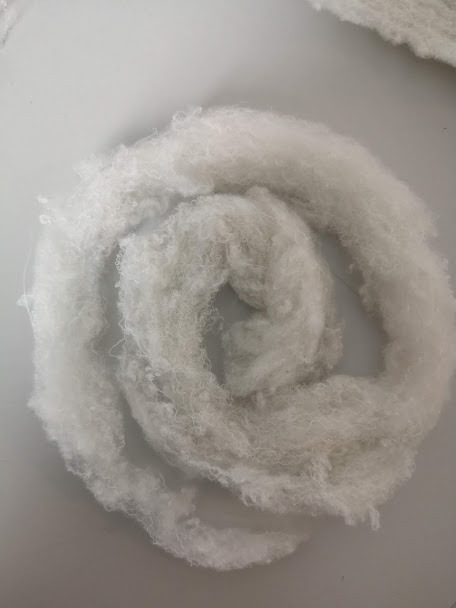
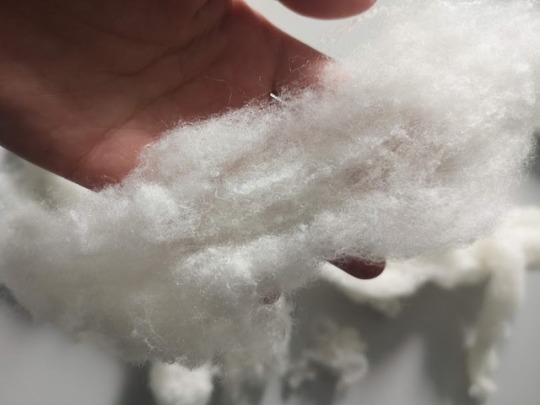
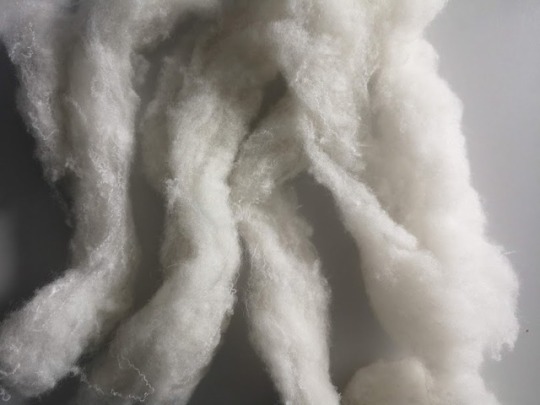
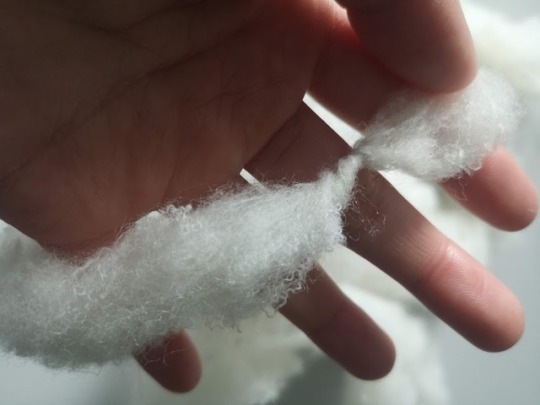
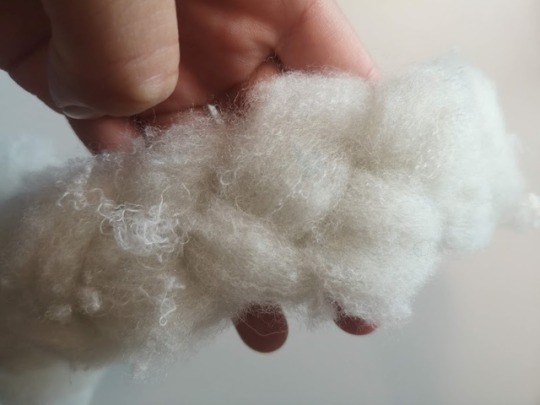
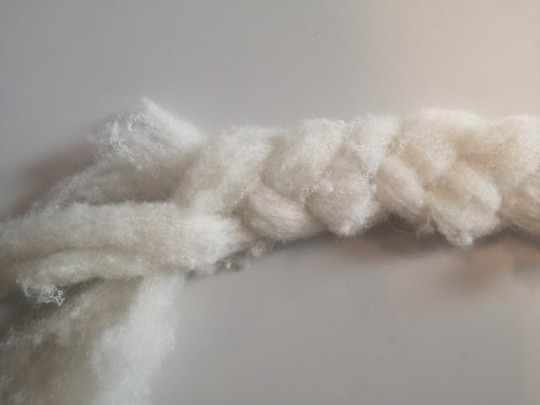

Making Rovings
To make wool rovings, I followed this simple tutorial (Marchwind. (2011, February 19)). All you need to do is to gently pull fibres through a small hole. I decided to make a chunkier, thicker roving as my fibres were not as fine as new wool. If I used a smaller hole, the roving would just separate the larger fibres and break the roving chain.
I tested this by pulling the fibres through a small hole in a bottle cap. This was really difficult as sometimes it would not pull through and it would break. I also used a bobbin wheel to pull fibres through and it worked much better as I could make the rovings longer lengths. Since I was using carded wool batts I had made, all of the fibres lined up vertically. With this, I could only make rovings lengthwise. I tried to pull the rovings continuously by attempting to connect with a new row as shown in my diagram above. There were some times it had worked and other times it just separated. However, there are still a lot of uneven chunks of the recycled wool that would come off of the rovings.
To make the fibres in the rovings combine better to use for chunky knits, I looked into a few different methods of felting. The first thing I did was to just use friction from your hands to lightly felt the outer layer ( BeCozi. (2018, February 4) ). This was done by just smoothing down the rovings by pulling it through the palm of my hands. The other method ( Truly Majestic. (2017, January 31)) that I tried was to use the drier. I first tied up the rovings to stop them from tangling in the drier. I then sprayed it with water to make it damp. I then put it into the drier for around 10 minutes. When I brought them out of the drier, the rovings were much fluffier but the spinning in the drier actually separated the length at some points. I tried needle felting 2 roving strands together but it did not work well, it still pulled apart easily but if I felted it too much it would make the connections really obvious which is not preferred for my overall final aesthetic.
I also tested on some rovings using my 100% recycled wool. These ones were much more difficult to work with as there were still a lot of chunky fibres. The results of these were much worse than that of the blended fibres.
References
Marchwind. (2011, February 19). how to make roving [Video file]. Retrieved from https://www.youtube.com/watch?v=UJCPkCoi3T4
Truly Majestic. (2017, January 31). How To Lightly Felt Wool Roving For Arm Knitting Yarn [Video file]. Retrieved from https://www.youtube.com/watch?v=-ADiPKQ_394
BeCozi. (2018, February 4). HOW TO FELT MERINO WOOL BEFORE KNITTING [Video file]. Retrieved from https://www.youtube.com/watch?v=A4QqzZwP4q0
Birek, L. (2012, October 30). Giganto Blanket Tutorial - How to graft roving ends together [Video file]. Retrieved from https://www.youtube.com/watch?v=GCex0Tb3obE
0 notes
Photo

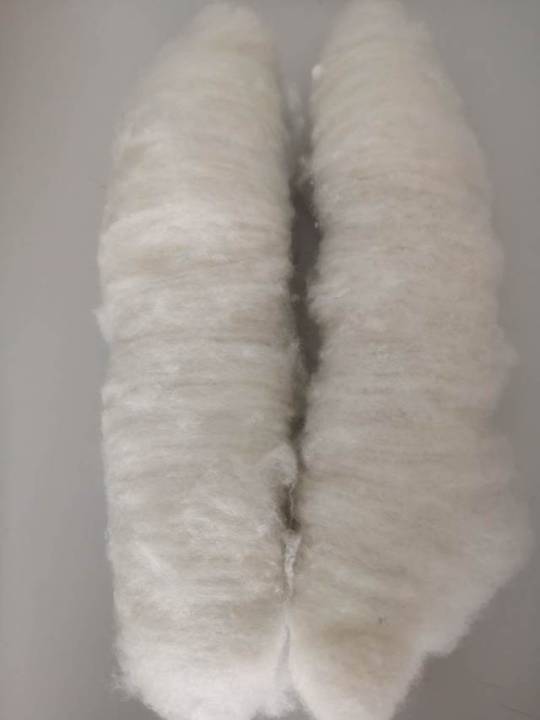

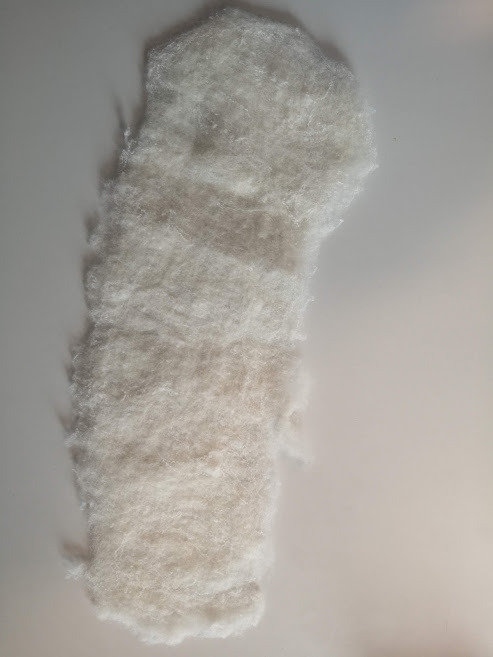
Carding Wheel
After using the smaller hand carder to refine the deconstructed wool shirt. I then used the carding wheel to blend the recycled wool fibres with new wool. I tested with layering both the materials and also blending before putting it into the carding wheel.
Both of the blended batts turned out surprisingly well. There were still some recycled fibres that did not blend in as well.
I then felted the mixed wool and it turned out surprisingly nice. The chunks that the carded fibres had were much less obvious. It took 5 passes through the felting machine to become an actual textile.
Next Steps
The next thing to do is to look at other ways that the fibres could be turned into textiles. I would like to look into making wool rovings to then use to make an article of clothing.
0 notes
Text
Studio - Final Concept
Inspiration
I actually wish that I had taken a picture of it but while I was in Queenstown, there was a craft market on Sunday by the lake. There was this store that sold handmade wool products. They had made these large chunky hand knitted scarves and throw. The yarn was really thick and chunky, it was really light so I thought that they might just be rovings.
The actual knitted rovings inspire my final artifact as the way it is made means that it would be recycled back into fibres quite easily.
Final Concept
For my final artifact, I would like to produce a garment using the fibres I have separated from an old merino wool shirt combined with new wool. I would use a combination of felting and knit to create a scarf. The reason I chose this is because it is a really simple but effective way to show the final outcome of my project, it is also simpler to return to fibres in this form.
--add pic of process--
Nostalgia
One of the reasons that I am using old materials for my project is that I can incorporate elements of nostalgia. One of the reasons that people will hold onto specific items would be the past memories of it.
0 notes
Text
Space, Image and Sound - Reflection
The overall concept of this project was really interesting to me. A statement installation on the addiction to phones and social media using phones. Projection mapping is something that is relatively new to me and this has turned out surprisingly well. I do really like this project.
My role in this project was the organization of the group and also working on the physical aspects of the installation. I feel that the actual management of the group was somewhat lacking, we did not have the best communication. We only had the group chat and meeting up and working on this project every Wednesday. We could have organized a few more meetings, but it still worked out very well because everyone had their own roles and knew what needed to be done. No one needed any dragging, everyone contributed to the project evenly. There were also quite a few influential decisions that I had made for the group such as, the original layouts and deciding on the backgrounds.
The actual process of this project was very easy as well. This is because we decided on what we wanted to do quite early on in the semester. We all had the same idea on what the final project would look like and we worked towards that.
0 notes
Text
Space, Image and Sound - Physical Presentation and Future Direction
--add pictures of projection set up--
This is our projection set up. There are still things that need to be moved around to prepare for open studio. We plan to use hazard tape to block off the area around and in front of the projector. This is so that people don’t walk in front of the projector or bump into it.
Future Direction
There were quite a few things that we discussed as a group, including the future direction for this project. One of these is the scaling of the installation. With the same method, we could enlarge the scale using a better projector, more phones and multiple speakers if we were given enough space. This is what I envision this installation to be in the future. I would love to see this projection in a larger more open space.
0 notes